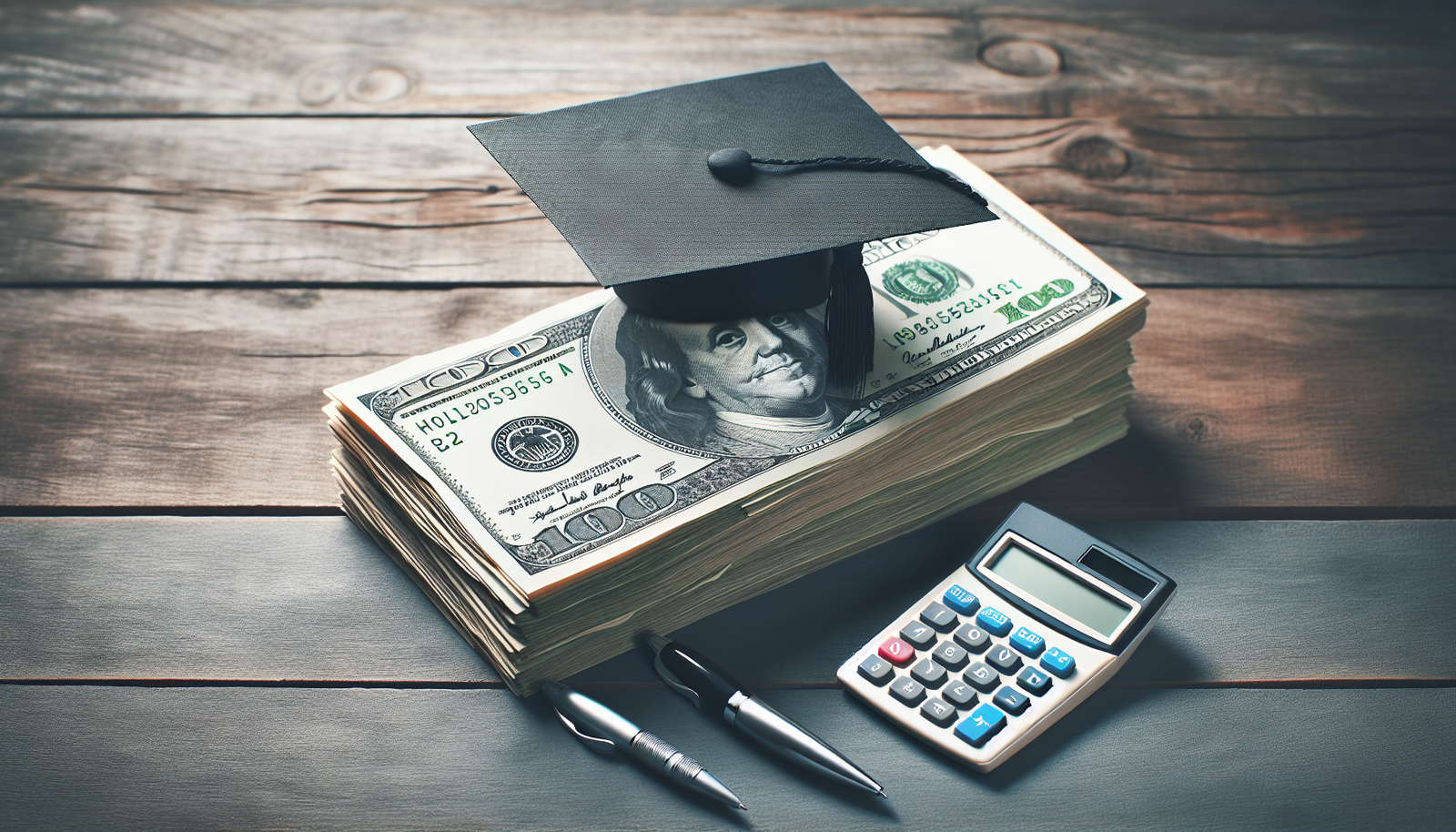
Navigating the world of borrowing money can be challenging and complex, especially when it comes to understanding the different types of loans available. We’re talking about everything from personal loans to auto loans, right down to mortgage and home equity loans. It’s a vast financial scenery that includes credit-builder loans, debt consolidation options, and the notorious payday loans – each one has its own set of terms and interest rates. However, this article primarily focuses on one of these – the student loan – and explores its role in the financial market, including how it compares to other types of loans in terms of interest rates. So, come along on this financial journey and discover the intricacies of student loans amidst the plethora of credit opportunities out there.
Understanding Student Loans
Definition of Student Loans
Student loans are a form of financial aid designed to help students pay for their post-secondary education and the associated fees, such as tuition, books and supplies, and living expenses. They differ from other types of loans in which they are designed specifically for students and usually have lower interest rates and more flexible repayment options.
History and Evolution of Student Loans
Student loans have a long history that can be traced back to the 19th century. The pressing need for educated manpower around the time of the second world war led to the institution of a state-funded educational loan program, setting the stage for today’s student loans. However, the structure of student loans, their terms, and the policies around them have evolved as education needs and the economic environment have changed.
Importance of Student Loans in Higher Education
Student loans play an integral part in enabling access to higher education, especially for underprivileged students. Without them, many people wouldn’t be able to afford the steeply priced higher education fees, limiting their future career prospects and earning possibilities. Student loans serve as an equalizer, ensuring everyone who has the will to pursue higher education can do so.
Types of Student Loans
Federal Student Loans
Federal student loans, as the name hints, are funded by the government. They are a popular choice as they normally come with lower interest rates and more lenient terms when compared to private student loans. They are further classified into Direct Subsidized Loans, Direct Unsubsidized Loans, and Direct PLUS Loans.
Private Student Loans
Private student loans are offered by private institutions like banks or credit unions. They are preferred when federal student loans, grants, and scholarships are not adequate to cover the total cost of education. These loans typically have higher interest rates and less favorable terms than federal student loans.
Parent Loans for Undergraduate Students (PLUS)
Parents of dependent students can take out loans to supplement their children’s aid packages. The federal Parent Loan for Undergraduate Students (PLUS) allows parents to borrow money to cover any costs not already covered by the student’s financial aid package, up to the full cost of attendance.
Consolidation Loans
Consolidation loans allow you to bring all your student loans — federal or private — into one mega loan under a new rate, which is the weighted average of your previous rates. They simplify the repayment process, but they might lead to a rise in overall interest paid in the long run.
Perkins Loans
Perkins Loans were federally funded loans, administered by the institution of the student, with a fixed low-interest rate. However, the program ended in 2017, and no further loans are being distributed under this scheme. Existing borrowers can still make repayments.
Applying for Student Loans
Eligibility Requirements
Be it federal or private, both types of student loans have eligibility criteria. For federal ones, you need to be a U.S. citizen or eligible non-citizen, demonstrate financial need, be accepted or enrolled in an eligible degree or certificate program, among other requirements. For private loans, credit score, existing debts, income, and other financial factors are usually considered.
Application Process for Federal Loans
To apply for federal student loans, you need to complete the Free Application for Federal Student Aid, better known as FAFSA. After filling out the FAFSA, you’ll receive a student aid report, which outlines your expected family contribution. Your college will then send you a financial aid offer, which may include federal student loans.
Application Process for Private Loans
Applying for private loans may vary depending on the institution offering the loan. However, it typically involves checking your interest rate, finalizing the loan amount, and submitting an application with details about your financial situation. It would likely involve a credit check.
Tips for Preparing Your Loan Application
It’s essential that you fully understand your financial situation and needs before you borrow. Research about different loan options, interest rates, the expected total repayment amount, and read the fine print carefully. Consider your potential future income and opt for a student loan with a repayment plan that complements it.
Interest Rates on Student Loans
What is an Interest Rate?
Interest rate is essentially the cost of borrowing money. It is a percentage of the loan amount that lenders charge for borrowing their money. For student loans, the interest might accrue while you’re in school, or it might be deferred until after you graduate.
Interest Rates on Federal Loans
Federal Loans usually have lower interest rates compared to private loans. As of July 1, 2021, the interest rate for undergraduate Direct Subsidized and Unsubsidized Loans is 3.73%. Direct PLUS Loans have an interest rate of 6.28%.
Interest Rates on Private Loans
Interest rates on private loans often vary and depend on several factors, including your credit score. They could be either fixed or variable. Fixed rates stay the same throughout the loan term, while variable rates fluctuate over time.
Factors Influencing Interest Rates
Interest rates are determined by various factors including the type of loan, whether it’s subsidized or unsubsidized, the creditworthiness of the borrower or cosigner, and the prevailing market conditions.
Repayment of Student Loans
Repayment Terms and Conditions
Usually, students don’t have to start repaying their student loans until after they’ve left school. The repayment terms, however, depend upon the type and terms of the loan. Most student loans have a grace period, but interest may start accruing right away.
Repayment Plans for Federal Loans
Federal loans offer several repayment options. There’s the standard repayment plan with fixed monthly amounts for up to 10 years. Income-driven repayment plans are also available, where the monthly payment is a percentage of your discretionary income.
Repayment Plans for Private Loans
Private loan repayment terms can vary depending upon the lender. Some private lenders do offer loan deferment while you’re in school, but some may require immediate repayments. It’s essential to understand the terms before signing up.
Defaulting on Student Loans: Risks and Consequences
Failure to repay a student loan can have grave consequences, like harming your credit score, inhibiting tax refunds, or having your wages garnished. It’s important to make a plan and stay on top of your repayment schedule to avoid these.
Loan Forgiveness and Cancellation
Public Service Loan Forgiveness Program
One loan forgiveness program to note is the Public Service Loan Forgiveness program for federal loans. After making 120 qualifying payments while working full time for a qualifying employer, the remaining loan balance is forgiven.
Teacher Loan Forgiveness Program
Under the Teacher Loan Forgiveness Program, if you teach full-time for five complete and consecutive academic years in a low-income school or educational service agency, and meet other qualifications, you may be eligible for forgiveness of up to $17,500 on your Direct Subsidized and Unsubsidized Loans and your Subsidized and Unsubsidized Federal Stafford Loans.
Closed School Discharge
If your school closes while you’re enrolled or soon after you withdraw, you may be eligible for discharge of your federal student loan.
Death and Disability Discharge
In the unfortunate event of death or permanent and total disability, federal student loans can be discharged, which means you are no longer obligated to make loan payments.
Deferment and Forbearance
Definition of Deferment and Forbearance
Deferment and forbearance are two options that temporarily postpone or reduce your federal student loan payments. While both can be helpful if you’re having trouble making your monthly payments, they affect your loan in different ways, especially in terms of interest accrual.
Qualifying for Deferment or Forbearance
Each has its unique qualification rules. Deferment can be granted for reasons like financial hardship or being back in school. Forbearance is mostly granted for financial difficulties or illness, but it’s not automatic and is reviewed case by case.
Interest Accumulation During Deferment or Forbearance
With both deferment and forbearance, interest continues to accrue on unsubsidized loans, and it can accrue on subsidized loans during forbearance. That interest can be capitalized, or added to the balance of the loan, increasing the total amount of the loan.
Impact of Student Loans on Credit
How Student Loans Affect Credit Score
Student loans can affect your credit in several ways. Positive effects come from making regular payments and reducing the balance. However, late payments or defaults would negatively affect the score.
Implications of Defaulting on Student Loans
Defaulting on a student loan can severely damage your credit score, preventing you from getting future credit or loans. It can also lead to wage garnishment and seizure of tax refunds.
Importance of Timely Repayment
Timely repayment not only saves you from extra costs due to late fees, but it’s also crucial for maintaining a good credit score—a key to financial flexibility in the future.
Student Loans and Tax Implications
Student Loan Interest Deduction
You can lower your taxable income by up to $2,500 through the student loan interest deduction. How much you can deduct depends on your modified adjusted gross income and how much interest you paid on student loans.
Education Credits
There are also two tax credits available to help offset costs of higher education by reducing the amount of income tax— the American Opportunity Tax Credit and the Lifetime Learning Credit.
Cancelled Debt and Taxes
Generally when a debt is cancelled it becomes taxable income. However, there are exceptions and exclusions for specific types of assistance.
Taxation of Loan Forgiveness Programs
Loan forgiveness issued by income-driven repayment plans is considered taxable income, but there are exceptions and specific rules depending on the type of forgiveness received.
Advice for Managing Student Loans
Budget Management Techniques
Establishing a well-defined budget to manage your living expenses and prioritize your spending can go a long way in effectively managing your student loans.
Understanding Loan Terms and Conditions
Ensuring you are well-versed with the terms and conditions of your loan is essential. This will give you a clear idea of your obligations, grace periods, deferment or forbearance options, and more.
Seeking Professional Financial Advice
It’s always a good idea to seek professional advice when it comes to managing student loan debt. They can offer strategies specifically tailored to your financial situation.
Useful Resources and Help Centers
Numerous resources and help centers can guide you through your student loan journey. This includes Federal Student Aid’s website, state aid agencies, and non-profit organizations that offer advice on managing student loan debt.
In conclusion, understanding student loans—their types, terms, and implications—is critical to making informed financial decisions and navigating the path of higher education. It opens up opportunities for everyone willing to pursue advanced education degrees. As with any important decision, researching and seeking advice while staying on top of updates and regulations can go a long way.

